View a slideshow of Bryce Wilson's SLO Marathon progression.
I started running four years ago. Since that time, I’ve lost 50 pounds and dropped two pants sizes. I’ve also grown numb to the sight of black toenails, bleeding nipples, and other things that would make normal people seek medical care. My left leg is a mass of varicose veins that resembles a relief map of the Badlands.
This is all beside the point.
If you run seeking a kind of makeover from the sneakers up, you will quickly learn to hate it, and you will probably give up before too long. If you run to seek macho war stories about how much you can take, the same thing will happen, only you will annoy more people in the process.
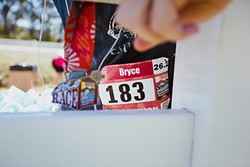
- PHOTO BY KAORI FUNAHASHI
So why run?
I’ve thought about it a lot. If running gives you anything, it’s plenty of opportunity to ask the question, “Why, oh why, am I doing this to myself ?” It’s certainly not for glory; my sub-four-hour marathon times barely rise to the level of “Not Pathetic” to the hardcore runner. I’m never going to make Boston, let alone win a race.
It’s not for the fabled “runner’s high”—though the sport is filled with ex-addicts and alcoholics, and by all accounts it’s a pretty good way to put down whatever substance is currently ruining your life (and the sensation of your spine secreting homebrew morphine never ceases to be weird).
“Running is cheaper than therapy!” reads a popular bumper sticker. I have no doubt that’s part of the truth, just as I have no doubt that good ol’ fashioned Catholic mortification of the flesh is some of it, too.
Running can’t help but appeal to my inner existentialist as well. The true opponent is never whom you’re racing against, but yourself. Every run is a pitched battle between your mind and body, seeing just how long you can keep doing something really uncomfortable before it gives out on you. On those rare transcendent runs, the mind/body disconnect gets thrown into sharp relief coupled with an odd feeling of dispassion, as though my body is a Ducati and my mind the test driver and if the former starts to redline—oh well.
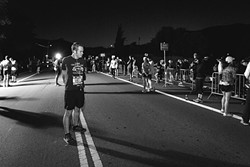
- PHOTO BY KAORI FUNAHASHI
Me being me, I’ve read an awful lot of books trying to figure it out.
I run because it’s the only evolutionary advantage we hairless monkeys have, claims Christopher McDougall in Born to Run. I run to seek the void, says Haruki Murakami in What We Talk About When We Talk About Running. I run to beat The Blerch, says Matthew Inman (aka The Oatmeal) in The Terrible and Wonderful Reasons Why I Run Long Distances, as a form of “practiced stoicism” against the inertia of laziness both internal and external. I run because like what else would you do, says the hero of John Parker’s cult novel Once a Runner. I run because it’s super awesome, bro!, says Cal Poly alum and ultra champion Dean Karnazes. I run because it fills the world with positive rainbow energization, says his rival Scott Jurek.
All of these are equally true—and equally beside the point (though Inman’s probably comes the closest). Just as you can’t treat running like a diet pill if you want to do it over the long term, you can’t search for a reason to run like it’s the Anti Life Equation or something. There’s no one sentence that will make your eyes clear and suddenly forget the fact that your body is screaming at you. “The trick,” as Peter O’Toole put it, “is not minding that it hurts.”
I can’t tell you when I started. Literally some of my earliest memories are of running, tearing around the fields near my old home, back when they were still wheat, not vineyards. But I can tell you when I stopped.
And I can tell you when I started again.
I fell out of love with running bit by bit, and by the time I actually tried to do it as a sport, the love had pretty much died. I tried to run cross country for two years before finally dredging up an excuse to quit. I wasn’t a natural fit, I didn’t get along with my teammates, and I didn’t exactly appear to be brimming with potential to my coaches. (In all fairness, they weren’t wrong; I’m built for stamina, not speed, and any reasonably competent high school varsity athlete could still burn me on a standard 5K course.)
But these are just excuses. If I had loved running, if I had been passionate about it, I would have kept at it no matter what. I didn’t. I hung up my shoes and didn’t put them on again for 10 years.
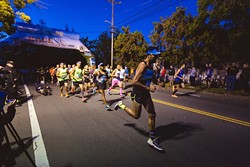
- PHOTO BY KAORI FUNAHASHI
I started running again because fear is a great motivator. In that 10-year ellipse, I had become an enthusiastic smoker. Though I had cut back after college, the hooks of addiction were still pretty well into me. As I prepared to move to Austin, I decided I really, really didn’t want to die of cancer. Having heard that the best way to quit was to move, and thus have no association between smoking and your favorite bars, restaurants, theaters, etc., I decided to give myself a little extra help by running again. I wasn’t seeking positive reinforcement, but negative. If I ever did slip up, I’d be running with tar-coated lungs. This is just as much fun as it sounds.
In early spring, Central Texas becomes the most beautiful place I have ever lived. The transformation is so swift and total that the beauty is almost perverse. Carpets of wildflowers spring up everywhere; the ever-present live oaks deepen to an alarmingly vivid green; the rivers and creeks, usually stagnant, run strong; and the sky opens up so huge that it threatens to give you vertigo. The summers are brutal and last approximately eight months, the autumns are nonexistent, and the winters are short but surprisingly harsh. But the springs? The springs are glorious.
My current favored 9-mile running course cuts through this country with the variety and careful arrangement of a Sonic the Hedgehog level. Trails gently diverge and converge through woods, alongside streams, down rolling hills, through parks, over bridges, under massive cityscapes, through bohemian neighborhoods, past Buddhist shrines, and around playground-like quirks of modern architecture. It’s so ideal, it’s almost ridiculous.
This is not where I learned to run again.
I learned to run off and on a highway that cut through the suburban sprawl of North Austin, which for those of you not familiar with the area is pretty much where the Austin aura wears off and the city becomes property of Texas again. It was a brutally ugly stretch of two-lane blacktop. The highway acted as a kind of de facto border between Austin and a neighboring city, and as neither wanted to claim it, it ended up particularly neglected. There wasn’t a sidewalk for most of it, and the shoulder could get uncomfortably tight, especially when pickup trucks were whipping by—and their drivers weren’t shy about letting you know that they don’t take kindly to runners ’round here, shooting you the finger if you were lucky, swerving into you if you weren’t. Broken glass and discarded cans littered the road along with animal carcasses that would lie there for weeks, baking in the Texas heat, before they were picked up or just rotted away. The closest I would come to seeing the wonders of nature was a homeless man pissing against the side of a Walmart.
In short, the run had nothing to offer me but the run. If I was going to keep running, I had to do it not because I loved the scenery or the community or the inner peace it offered, but because I loved the run for itself. It took me a while.
* * *
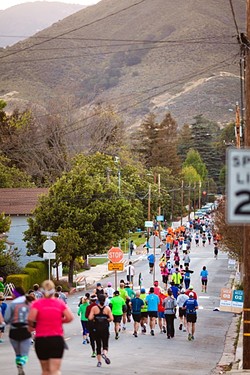
- PHOTO BY KAORI FUNAHASHI
Samantha Pruitt also started running to change her life. At 25 and 5-foot-4, she weighed 185 pounds. The toll that combination started to take on her health was severe. As she puts it, “The choices you make each and every day—each moment, really—can add up to a pile of crap and misery.” Unable to lose weight through traditional means, she took herself back to formula.
“I decided to ‘Just get up and do it differently today,’” she explained. “I chipped away at my new body and new life.”
She went back to school to study holistic health and created an exercise regime centered on running. By 2003, she’d moved to the Central Coast to work as a personal trainer. By 2004 she was doing triathlons, by 2010 marathons, by 2011 an Iron Woman, and in 2012, an ultra, a race of more than 30 miles—the final level of racing before you just start Forrest Gumping it. It’s the outer limits of endurance sport. If runners mystify the general populace, then ultra runners occasionally mystify runners. To get there, you have to know why you run.
“Ultra and trail running became a lifestyle that felt authentic,” she said. “It grounded me. ... I dug deep into myself to a place I had never discovered before. ... I think to get there, you must peel back all the layers of yourself. ... Each ultra experience has been totally different (some fun, others brutal), and yet each one has made me feel more alive, more grateful, and more focused on my real life’s purpose.”
In the midst of this, Pruitt decided that running races wasn’t enough. She wanted to run her own. Together with her business partner Heather Helleman, she founded Get Off the Couch Sports Productions (now Race SLO). They held their first race, the Central Coast Cancer Challenge, in 2010, an event close to both of their hearts, as both of their families were affected by the disease. That race started as a 5K. The marathon would start two years later.
“It took time to convince all the players what a huge financial impact this would be to the county … ,” she explained. “They (local government, city, county, Caltrans, SLOPD, CHP, business community, etc.) all needed to trust us. ... They needed to see we were professionals and could execute this huge event.
“I knew as a local runner and coach that SLO Town needed and deserved a world-class race. The climate, beauty, and energy that organically flows here is unlike any other marathon running venue I have ever experienced. ... We know what we have is special and are very proud to share.”
It took two years of bargaining, pre-selling, and politicking to make the ambition a reality, but the event launched. The first SLO Marathon took off in 2012 with an estimated 2,800 runners. By last year, that number had swelled to 4,200. This year Pruitt was anticipating 5,000 runners (actual numbers ended up being 2,216 half-marathon runners and 499 full-marathon runners). Race SLO has grown along with it. The SLO Marathon is now run with the help of 60 managers and 900 volunteers, and the company now runs a third race as well, the cycling expo Giro Della Costa Centrale.
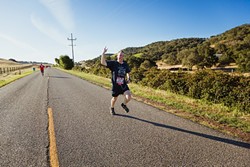
- PHOTO BY KAORI FUNAHASHI
More importantly, Race SLO has been able to expand its philanthropic enterprises. Its Cancer Challenge has raised nearly $50,000, and the organizers have started a mentorship program within the Grizzly Youth Academy, which trains and sponsors 150 athletes a year, taking them from the basics through their first half marathon. This one is particularly close to Pruitt’s heart.
Between its events and its charitable work in the community, Race SLO is firmly entrenched in the Central Coast, and it would be easy to imagine its events growing indefinitely. But Samantha wants to keep the race intimate: “We will ... cap the race at 10,000 maximum,” she said. “We never want to be a Rock n Rock or an overgrown cattle call race. Authentic old school running with a soul—that is us.”
That sounded just right. Since I’d started running, I’d run two marathons: one in Austin the other in New Orleans. But I wanted to go back to the beginning, to the place where I had started running, the place I had given it up. The place I had to test myself. The only place that really matters.
I had to come home.
In a way, running is magic—not in the sense that it is easy, or doesn’t require effort, but in that it is ineffable and governed by its own rules. Every run is an act of faith; you have to reach down inside yourself and hope that the strength you’ve painstakingly built is there when you call on it. There’s no guarantee, and every runner can relate to the sinking sensation of trying to draw on those reserves only to find that that day, for whatever reason, they’ve disappeared, abandoned you.
This can be nerve-wracking, especially when you’re none too sure of the strength you’ve built to begin with. I was feeling less than prepared for this race. Personal drama, a persistent illness, and a minor injury conspired to keep me sidelined for almost a month, and by the time I realized how much I’d lost since running New Orleans, there was precious little I could do about it. I trained as much as I could, but by the time I walked into the SLO High parking lot, there was no guarantee that I wasn’t about to completely implode and then have to write up said implosion for a feature article.
The feeling of apprehension persisted at the starting line. The mood felt oddly subdued, without much conversation between the runners. Everyone seemed locked in their own little world as they ran their last-minute drills and stretched. My trusty, pensive, prerace song “The Foggy Dew” (which makes me want to start a fight with the entire country of England) felt oddly appropriate.
The usual ceremonies were performed—short speeches from the City Council, the national anthem, the blasting of the Katy Perry—and then we were off in the pre-dawn dark, running through the town’s streets. I struggled to find a good pace. It doesn’t matter how well you’ve trained yourself or how many races you’ve run in; those first adrenaline-inspired moments of the race, it’s hard not to convince yourself that a PR (personal record) is not merely imminent, but manifest. That despite all evidence to the contrary, this will be much, much easier, and you shall be much, much faster than you would have ever dared believe. It’s as though a moron has seized control of your body, and you must wrangle it back. You have 25.4 miles left to run, dummkopf. Just what the hell are you thinking?
I forced myself back from the 3:45 pacer, but my legs were already feeling heavy. I turned just in time to get a full-faced blast of the rising sun, and to belatedly realize that I had forgotten sunscreen. Five a.m. is not my natural habitat, and it’s inevitable that I was going to forget something. I do every race. This time, it was protection from the big scorching ball in the sky—a minor thing for some runners, but a disaster for my pale, thoroughly Irish ass. Three miles in, and I was jittery, my muscles felt heavy, and I was about to burn. I hadn’t even made it to the first hill yet.
No, this was not going well.
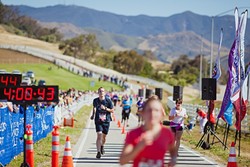
- PHOTO BY KAORI FUNAHASHI
As I made my way to said first hill, the behemoth crusher of souls that we so quaintly call Johnson Avenue, I was able to flag down a medic, who dutifully squirted some sunscreen into my palm. I took off again, rubbing the sunscreen into my face, caking it on so unevenly and thickly that I looked like Jared Leto trying to ruin The Joker. Because the first rule of marathon running is: Why stop and do something well when you can keep going and do it poorly? As I crested the top of Johnson Avenue, a hill I’ve run, walked, ridden, stumbled, and staggered up innumerable times, the sweat streaking the white mask as though I were a fitness-crazed Pagliacci ruining his makeup with perspiration instead of tears, the sky turned a Monet-like vanilla, and I took in the crazed sight of the hundreds ahead and behind me, and suddenly I couldn’t help but feel a swell of gratitude for this ridiculous, stupid, wonderful thing that we do.
From there, it was easy. Or, well, easy-ish. While it’s hard not to wish that the San Luis Obispo Marathon incorporated a bit more of San Luis Obispo—the course bypasses the north side of town, and the absence of the likes of Cal Poly, Foothill Boulevard, and Los Osos Valley Road felt odd—this does allow the Edna Valley to be run in pretty much its entirety. This is, as they say, pretty sweet. It’s as idyllic a course of pulverizing hills as you could ask for, and it slipped by fairly breezily.
That is until around mile 18. In all three of my races so far, there’s been an uncannily consistent parabola of energy. Up until mile 16 or so, I’m feeling no pain—or at least much less pain than you would think someone who just ran 16 miles would feel. By mile 17, dippy utopian thoughts have entered my head: Running is great! I think. Marathons are great! Everything is great! Everyone should do them! All the time! Such thoughts dance through my head until mile 18, when every joint in my body from the hips down fuses, and it suddenly feels like I can’t take another step. I don’t know if it’s the wall, but it’s certainly a wall, and one that seems to have it out for me.
It feels like I can’t run another mile, which is problematic considering I have eight of them left to go. Not that distance matters at this stage. Whether you have 1 mile to go or 10, when the pain gets in you this way, there’s only one distance: farther. And it never gets any shorter. All I can do is stumble forward, try not to let my pace go completely to shit, and once again ask myself the age-old question: “Why, oh, why am I doing this to myself?”
* * *
I had found my answer a while ago. Like most important revelations, it came to me while I was on the couch, incapacitated, watching children’s cartoons. It was early in my attempt to become a runner again, and it wasn’t going well. My legs ached, my feet were blistered, and I was hot, sunburned, and tired. I couldn’t figure out why I was doing it to myself.
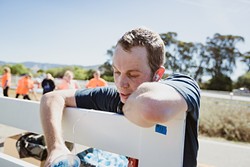
- PHOTO BY KAORI FUNAHASHI
As I dimly watched the brightly colored characters zip around on the screen, a few sodden synapses started throwing dim sparks. They looked like they were having fun. They were having fun running. Such a thing was possible. Hadn’t there been a time when running was fun? Might there be again? The next time I went out, I approached things very differently.
There’s the big secret: I don’t run because it puts me on some advanced spiritual plane. I don’t run because it burns calories like a furnace. I don’t run because I’m addicted. I run because it’s fun. Going fast where you’re not supposed to is fun. Pitting yourself against strangers is fun. Testing your limits, pushing yourself, getting scraped up, and making yourself panting-dog tired is fun. I run because, thank God, I have never quite lost the desire to go out and play.
Considering that the city had turned itself into a playground for me, it would have been rude for me not to finish.
* * *
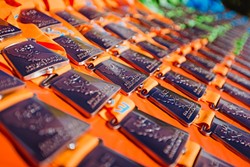
- PHOTO BY KAORI FUNAHASHI
I made it to the end with a decidedly non-pathetic four-hour time. It wasn’t pretty, but that’s the flip side to the only distance being “farther”: Eventually, it runs out (this is where the whole “practiced stoicism” comes in). I ran in beautiful country and down familiar streets, pushed my body until it screamed vows of horrible vengeance, and I did it surrounded by 500 fellow maniacs.
Yeah, I had fun.
Email regular contributor Bryce Wilson about his favorite running trails at [email protected]. Send comments to the executive editor at [email protected].
PHOTOS BY KAORI FUNAHASHI
Comments